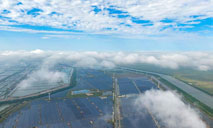Xi Focus: World's largest water diversion project sows lasting rewards
BEIJING, May 14 (Xinhua) -- Xi Jinping, general secretary of the Communist Party of China Central Committee, on Thursday inspected the South-to-North Water Diversion Project in the city of Nanyang in central China's Henan Province. On Friday, he convened a symposium on advancing the high-quality follow-up development of the project.
The project is the largest of its kind worldwide. It transfers water from the Yangtze River to dry areas in north China through eastern, middle, and western routes.
In Xi's words, it will benefit generations beyond. For over six years since it started supplying water, the project has helped moisten the arid north, but its significance extends well beyond water supply.
ECONOMIC LIFELINE
The distribution of water resources is uneven in China. The north is relatively dry, and the south, blessed with the Yangtze River, is better off regarding water supply.
The project is a significant strategic infrastructure to optimize water resources, boost sustainable economic and social development, and improve people's livelihoods, Xi said in 2014.
Official data showed that by March, the project had transferred over 40.8 billion cubic meters of water to China's northern areas for more than six years. It directly benefits more than 130 million people.
More than 40 big and medium-sized cities received water from the project, and in Beijing, around 70 percent of tap water is pumped in through the middle route.
The project has also helped the ecological restoration of rivers and lakes along its eastern and middle routes. It supplied over 5.2 billion cubic meters of water, according to the Ministry of Water Resources.
In droughts and related emergencies, the project provided life-saving water. The eastern route, for instance, helped ensure a rice harvest in 16 million mu (about 1 million hectares) of farmland in north Jiangsu Province last April.
After years of operation, the mega project has served as a significant lifeline to secure the prosperity and coordinated development of the north and the south.
CONSERVATION FIRST
Although the spatial distribution of water resources in China has improved with water diversion, China still faces water shortages, with per capita water resources being only one-fourth of the global average.
That explains why the country has been prioritizing saving water while ensuring the safety of water resources.
Xi has long attached great prominence to water conservation. During an inspection tour in east China's Jiangsu Province last November, Xi stressed guiding the development of cities and industries based on water capacities and making more efforts in water conservation.
"More south-to-north water supply should not happen in tandem with willful water wastage," Xi said.
Official data shows that the country has made solid progress in water conservation and enhancing water-saving consciousness.
Industrial firms have adhered to government guidelines and action plans on green development and saving water. It has helped reduce water consumption per 10,000 yuan (about 1,556 U.S. dollars) worth of industrial output by 27.5 percent from 2015 to 2019.
Rural areas are transforming farm layout, perfecting a tiered water-pricing mechanism, and increasing irrigation efficiency.
As a result, China's water consumption per 10,000 yuan of GDP is down 23.8 percent from 2015 to 2019, official data showed.
With the advancement of the massive project, the country hopes to see more institutional improvements driven by reforms to boost eco-friendly business and economic development.
For instance, involved parties have been encouraged to explore a sound water pricing mechanism that can promote water conservation and generate reasonable returns so that more businesses will participate in the construction and operation of water conservancy projects. Fiscal support is also expected to be innovatively delivered to facilitate safe drinking water projects in impoverished areas in the central and western regions.
The country has vowed to keep annual water consumption under 670 billion cubic meters by 2022, when saving water becomes a norm, and under 700 billion cubic meters by 2035, when the country realizes world-leading water conservation and reuse.
LASTING BENEFITS
"Ecological and environmental investment is not a futile or ineffective investment, but a basic and strategic investment that concerns the high-quality and sustainable development of the economy and society," Xi said during his inspection tour in Jiangsu.
As one of China's most significant environmental undertakings, the South-to-North Water Diversion Project will continue to help drive the country's medium to long-term growth.
The western route is now in the pre-construction stage and could add around 40 billion cubic meters of water. Experts say it will balance growth potential among different regions.
By 2035, provincial regions like Shanxi, Beijing, Tianjin, and Shandong will each face 1 to 3 billion cubic meters of water shortages, which can be expectedly relieved by the western route, said Wang Guangqian, an academician with the Chinese Academy of Sciences.
Also, the diverted water will likely help treat large expanses of desertified lands along the middle to upper reaches of the Yellow River. This water could even turn them into fertile farmlands covering around 100 million mu.
The prospective economic yield from the future farmlands is greater than the cost of the western route project itself, according to Wang.
From an energy perspective, this route could stimulate clean energy generation by adding hydropower to west China energy hubs like Shanxi and Qinghai provinces, thus contributing to the pursuit of achieving carbon neutrality by 2060.
Photos
Related Stories
- Xi extends congratulations on China's first Mars landing
- Xi Focus: Xi convenes symposium on follow-up development of China's mega water diversion project
- Xi stresses striving for people's well-being
- Xi visits resettled residents of China's mega water diversion project
- Xi Jinping on China's water diversion project, water conservation
- Xi inspects China's mega water diversion project
- "Xi Jinping Collection Room" in S. Korea's top university meaningful to learn about China
- Xi inspects central Chinese city Nanyang
- Xi calls for promoting innovative development of fine traditional Chinese culture
- Xi Jinping on family values
Copyright © 2021 People's Daily Online. All Rights Reserved.










